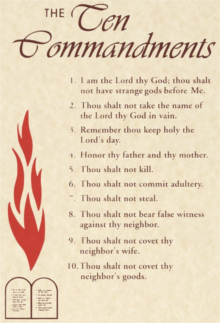
Faced with these consequences, the people recognize their sin and repent. The serpents bite many people and killed them. When the Israelites, wandering in the desert, complain against God, God punishes them by sending seraph serpents among them. One incident in the book of Numbers involves God specifically commanding Moses to make a statue. They can even be present in the very place where God is worshipped. We see that as the history of Israel progresses, statues and images of heavenly things (namely angels) are not opposed to worship of God. Similarly, when Solomon builds the Temple at God’s command, he decorates it with images of cherubim (1 Kings 6). Why? Because people were not worshipping them. In this larger context it is clear that images of angels did not contradict the commandment about images.

This is not only part of the Bible, but part of exactly the same book that contains the prohibition in Exodus 20:4. When the Ark is made, in accordance with God’s commandments, it includes images of cherubim (Exodus 37:7). The Ark of the Covenant was the place where God’s presence dwelled. In some cases we even see God commanding people to make images. When we read the Bible as a whole we see many instances in which images are used in worship. What did the great heroes of the Old Testament do with images? Did they ever make images of anything on earth or in heaven? Or did they completely ban the use of such images? The Ark of the Covenant Just as it is important to look at the immediate context of the command not to make images, it is important to look at the broader context of the Bible. Looking at the Context: The Rest of Scripture Therefore, what the commandments prohibit is not statues, but rather idols. Now we can see that when the commandment is not referring to the act of carving statues, but of carving them and worshipping them in the place of God. Given that Exodus 20:5 comes right in the middle of verses about worshipping God, it makes sense to interpret it as a prohibition against worshipping images, rather than against making them. …you shall not bow down before them or serve them. To further understand this verse, we need to look at what follows it: Why do Catholics read it this way? It seems like interpreting Exodus 20:4 as a different commandment, as Protestants do, makes just as much sense as interpreting it the way Catholics do, as a continuation of the First Commandment. Images themselves are not the problem rather, the problem is using the images in the wrong way. Exodus 20:2-3 (NAB)įor Catholics, the prohibition against images is understood in the context of having no other gods. I am the LORD your God, who brought you out of the land of Egypt, b out of the house of slavery. Immediately preceding Exodus 20:4, we read: Whenever we look at the Bible, it is important to look at the context surrounding it. The reason for this is that Catholics look at the context of this verse in light of what precedes and follows it. Catholics number this differently, as part of the First Commandment. Looking at the Context: Exodus 20Įxodus 20:4 is what Protestants list as the Second Commandment.
Graven images biblical full#
Given that Catholic churches are often full of the likenesses of things in heaven and on earth, this seems to be a clear violation of the commandment in Exodus.

You shall not make for yourself an idol or a likeness of anything in the heavens above or on the earth below or in the waters beneath the earth… Exodus 20:4, New American Bible (NAB) However, doesn’t this violate the Second Commandment? This commandment states: Many churches have statues of Mary and other saints, and every church should have a crucifix somewhere near the altar. It is no secret that Catholics make use of statues in their worship.


 0 kommentar(er)
0 kommentar(er)
